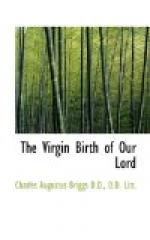— * Life of Bishop Westcott, vol. ii. p. 308. —
It is sometimes said, in opposition to the mystery of the Virgin-Birth, that there is a tendency in the human mind, not without its illustrations in history, to “decorate with legend” the early history of great men. In reply, it may be enough here to say that legends analogous to the pagan legends of the births of heroes, false and absurd legends, did gather round the infancy of Jesus Christ. The Apocryphal Gospels are full of such legends. They tell us how the idols of Egypt fell down before Him; how His swaddling-clothes worked miracles; and how He made clay birds and turned boys into kids, and worked other absurd miracles of various kinds. But there is a world of difference between these “silly tales” and the restraint, purity, dignity, and reserve which characterize the narratives of the first and third Evangelists. “The distinction between history and legend,” says Dr. Fairbairn, “could not be better marked than by the reserve of the Canonical and the vulgar tattle of the Apocryphal Gospels."*
— * Quoted in Gore, Dissertations, p. 60. —
I wish to take this opportunity of thanking my colleague, the Rev. G. W. Douglas, and my friend the Rev. Canon Warner, Rector of Stoke-by-Grantham, for their kind help in revising the proof-sheets of this paper.
B.W.R.
Theological College,
Ely,
Feast of St. Mark, 1903.
[Note on transliteration of Greek quotations: o = omicron (short o); e = epsilon (short e); o = omega (long o); e = eta (long e)]
THE VIRGIN-BIRTH OF OUR LORD
There are two miracles confessed in every form of the Creed—the miracle of the Conception and Birth, by which the Incarnation was effected; and the miracle of the Resurrection. These are the fundamental miracles, and are the battle-ground upon which the defenders and assailants of Christianity more especially meet.
The discussion of this most sacred subject of the Virgin-Birth of our Lord has been forced upon us at the present time. It is impossible to ignore it or set it aside. We must be prepared, each of us, however much we may shrink from treading on such sacred ground, to give a reason for the hope that is in us with reverence and fear.
I will ask you here and now to consider the matter briefly under four heads. First, I will try to give the evidence for the belief in this article of the Creed during the second century; next, I will ask you to consider the evidence of St. Matthew and St. Luke; thirdly, we will consider the argument e silentio on the other side; and lastly, I will ask you to reflect on the theological aspect of the question.




